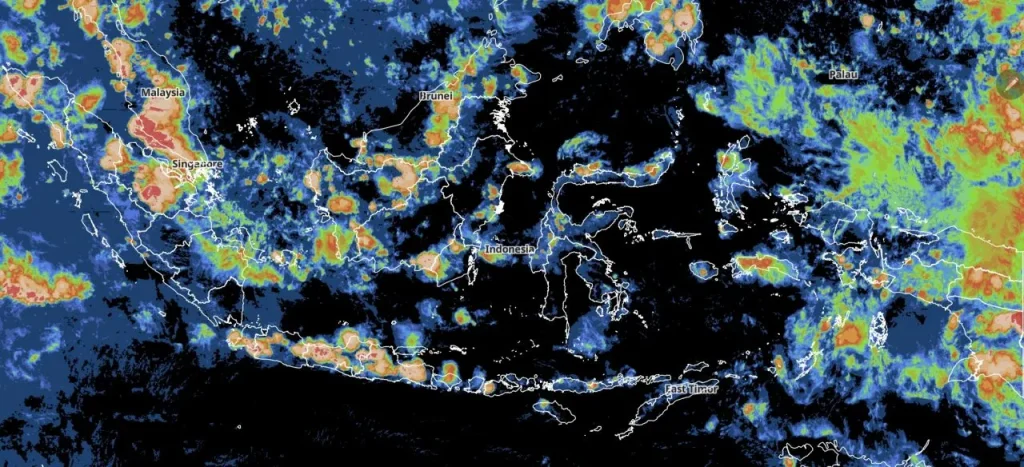The Impact of the Australian Monsoon on the Drastic Temperature Increase in Java Island
Factors Behind the Scorching Weather Gripping Java Island
Recently, many people in Java Island have been experiencing intensely hot and scorching daytime weather. The searing air temperature feels unusual for a tropical region like Java. So, what is actually happening? This hot weather phenomenon is not a single event, but rather the result of a complex interaction of various meteorological factors. One of the main causes behind the soaring temperatures is the phenomenon of the Australian monsoon, or scientifically often referred to as the Australian Winter Monsoon. This article will explain how the flow of air masses from the Australian continent systematically drives the temperature increase that we can feel directly.

Photo: Hot Weather Hits Several Regions in Indonesia. (Source: BMKG)
Unveiling the Causes Behind the Hot Weather Gripping Java
Understanding the characteristics of the Australian Monsoon is the first step in analyzing its impact. This phenomenon is a wind flow that moves from the Australian continent towards Asia, generally active between April and October. During that period, Australia is entering its winter season, which forms a high-pressure air system over its landmass.
Although officially called the “Winter Monsoon,” this term can actually be misleading. In reality, this air mass blowing from the Australian landmass is dry and continental. As it passes over the deserts and dry regions in central and western Australia, this air carries very little water vapor. Consequently, when it finally arrives in the Indonesian archipelago, including Java, this wind reveals its fundamental nature: very dry air with low humidity levels. This dryness is the key to the temperature increase we feel. So, what is the exact mechanism?
- Minimal Cloud Cover.
First, minimal cloud cover. The dry air inhibits the formation of rain clouds, which usually function as a natural umbrella. With skies tending to be clear, solar radiation reaches the Earth’s surface more intensely and with fewer obstacles. This radiation is then reflected back as heat, but because there are no clouds to trap it, the heat becomes confined in the lower atmosphere. This condition creates an oven-like effect during the day.
- Low Humidity Levels.
Second, low humidity levels play an important role. This condition makes the process of sweat evaporation from the skin more efficient. Physiologically, this causes us to feel a “dry” and scorching heat, different from humid heat which tends to feel muggy. Although the body actually cools itself more easily in dry air, the sensation of heat from direct solar radiation feels much stronger.
- Local Warming Exacerbated
Third, local warming is exacerbated by the urban environment. The combination of blazing sunlight with land surfaces and urban areas like concrete and asphalt, which easily absorb heat, triggers a drastic temperature rise. The Urban Heat Island phenomenon becomes even more pronounced under these dry season conditions, causing metropolitan areas like Jakarta, Surabaya, and Bandung to experience higher temperatures compared to their surrounding areas.
It is important to understand that the Australian Monsoon rarely works alone. Its heating effect is often reinforced by other interacting weather phenomena. For example, Heatwaves occurring in Australia. When the continent experiences extreme temperatures, the air mass moving northward carries a higher initial temperature. Other weather anomalies, such as high-pressure phenomena in the South China Sea, can strengthen and stabilize the easterly monsoon flow. Interactions like this cause periods of dry and hot weather to last longer than usual, prolonging the duration of the scorching temperatures we experience.
Conclusion
The significant temperature increase in Java Island during the dry season is directly correlated with the activity of the Australian Monsoon. Its main impact stems from the dry character of this wind, which triggers two main mechanisms: (1) a significant reduction in cloud cover, allowing solar radiation to reach the Earth’s surface with little obstruction, and (2) low air humidity levels that transform the sensation of heat into a more scorching and searing one. Therefore, the hot weather we are experiencing is not just an “ordinary dry season,” but rather a direct consequence of the flow of dry air masses from the Australian Desert enveloping Java Island. This heating effect is further exacerbated by local urban conditions and other reinforcing weather factors. Understanding this mechanism is a crucial step as a basis for anticipating and adapting to periods of extreme weather in the future.
Firman, M. (2025, July 3). Angin Monsun Australia Bergerak ke Asia, Ini Dampaknya Bagi Indonesia. beritasatu.com. https://www.beritasatu.com/nasional/2900925/angin-monsun-australia-bergerak-ke-asia-ini-dampaknya-bagi-indonesia
Wibawana, W. A. (2024, July 16). Tentang Angin Monsun Asia-Australia dan Dampaknya Bagi Indonesia. Detiknews. https://news.detik.com/berita/d-7441761/tentang-angin-monsun-asia-australia-dan-dampaknya-bagi-indonesia

